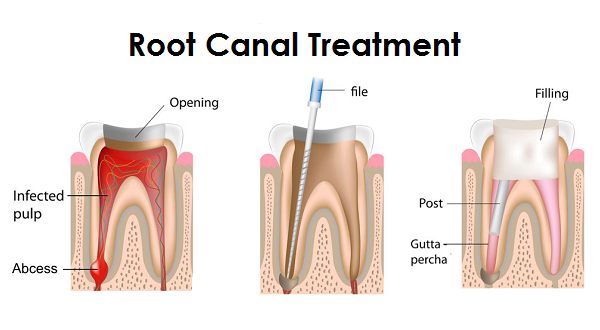Root Canal Treatment
What is Root Canal Treatment?
Root Canal Treatment is a dental procedure that is performed to treat the infected pulp of a tooth. It is also called the endodontic treatment. It comes under Endodontic treatments. The Endodontist is the dentist who is trained to perform RCT.
The human teeth are actually made up of the following:
- Enamel: is the hard structure on the outside that surrounds the Dentine.
- Dentine: is also hard and it makes up the bulk of a tooth. It consists of small fluid-filled tubules (Dentinal Tubules) extending from the pulp chamber housing the pulp tissue to the enamel.
- Pulp: is the central portion of the tooth and consists of connective tissue with cells, blood vessels, nerves, lymphatics etc.
The decay of a tooth, if left unchecked, will first breach the enamel and also the Dentin, leading to the inflammation of the dental pulp. The patient will experience Root Canal Pain and would require immediate dental treatment.
The dentist would normally opt for removing the dental pulp with all its blood vessels and nerve connections. This procedure of removing the pulp is called RCT. It actually involves the cleaning and sterilization of the root canal and the removal of the tissue from the canal.

Causes for Tooth Pulp Damage
The tooth pulp can be damaged by the following common causes:
- Cracked tooth
- Deep Cavity
- Trauma to the tooth
When is Root Canal Treatment Needed?
The Dentist usually recommends the root canal treatment if an infection has affected deep into the tooth. The tooth’s pulp can be infected by either an injury or a severe cavity that has been left untreated. This infection, if left untreated, can lead to the tooth’s extraction itself and replace with a Dental Implant, dental bridge or Dentures, which are costlier and also time-consuming.
Root Canal Procedure
The Root Canal treatment procedure is usually done in a series of steps as shown below:
- Diagnosis
The dentist will prescribe a few tests to check whether the tooth really requires RCT. This is usually done after a simple filling doesn’t solve the problem. A Cold or Heat test will confirm whether the tooth’s pulp is infected or non-vital or dead. X-ray of the tooth is taken to confirm how far deep into the tooth the decay has progressed and also how close to the dental pulp. The vitality of the pulp is checked using additional tests. A Cold or Heat test will confirm whether the tooth’s pulp is infected or non-vital or dead.
- Pre-Procedure Activities
The infected tooth is administered local anaesthesia by the dentist. This will cause numbness to the tooth and the patient might feel a small pinch at the time of needle entry. Once the local anaesthesia takes effect, the dentist will place a dental dam or a small rubber sheet to isolate the tooth. This will keep the tooth dry and clean during the procedure.
In some cases, if the infected tooth has collected a lot of pus, it might not respond to local anaesthesia. In such cases, the Nerve block technique of anaesthesia is administered.
- Pulpectomy
The dentist will open the tooth’s top portion using a small drill. This will help them to access the root canal system and the damaged pulp. This accessibility will enable the use of endodontic or RCT specific instruments that are flexible and can move deeper into the tooth for easy access to the root canal.
The damaged and diseased pulp is then removed from the inside of the tooth using small files. The inner chamber of the tooth and the root are then shaped. The chamber will be then cleaned using water by irrigating it. Then the chamber and the canals are cleaned using disinfecting solution killing the remaining bacteria and to reduce further risk of infection.
In cases of a highly infected tooth, the patient might need more than one appointment. In such situations, a medicament is placed inside the prepared canals. Then it is temporarily sealed for a couple of weeks.
- Filling
This next step involves the sealing of the prepared disinfected root canals. The root canal which is decontaminated and the chambers are filled with Gutta Percha, an inert rubber-like material. A temporary filling is used to seal the opening, for the time being.
Once the root canal is filled, the pulp chamber is filled. It is called Core Filling and composite or tooth colour is used.
- The Endodontist will provide a fully covering cap or Crown for the tooth whose root canal has been treated.
- A series of X-rays are taken throughout the procedure. The dentist might prescribe an antibiotic to help fight the infection. The tooth is protected with a permanent crown a few days after the completion of the procedure.
Post Procedure
- This treatment usually provides relief from the pain with a minimal recovery time.
- Root Canal treatments have a high success rate and usually last a lifetime with proper care.
- Patient must maintain good oral hygiene and take care of the teeth. Sugary foods and smoking must be avoided.
Authored by
DR.NIRANJAN P

